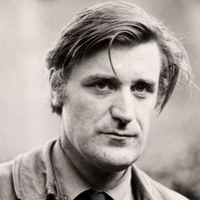Hawk Roosting by Ted Hughes: Summary and Critical Analysis
Ted Hughes' poem 'Hawk Roosting' on its literal level of meaning is an expression of a bird of prey, the hawk, which is sitting on a tree and meditating about its power of destruction, its ability to suppress change, and its conceited arrogance and superiority.

Ted Hughes (1930-1998)
But, since there is a clear projection of human attributes to the bird, we can easily see that the poem is an implicit satire on a tyrant that the bird represents. More generally, it could be said that the bird is a symbol of the human evils of arrogance, destructiveness, conceited and egotistical attitude, obsession of power and tyranny; in short, the hawk is a symbol of inhumanity.
The poem is composed in the first person narrative (I, my, me, mine), and it represents the thoughts, in a kind of internal monologue, through the mind of the hawk or the poet supposing that the words of the poem flow through the mind of the hawk. Hawk, a bird of prey, is a fierce, cruel and arrogant creature. The poem gives us a vivid impression of the spirit, or character of the hawk – of the particular manifestation of the life-force that is seen in it.
The hawk makes a short, sharp statement. I sit at the top of the wood. There I close my eyes and remain in inaction because this is possibly the time for rest. My feet and head are firmly fixed. I rehearse even in sleep, my perfectness in killing and eating. The paraphrase of the poem goes something like this:
I am the being perched on the high trees. The floating of the air, the rays of the sun are the advantage to me. The earth shows its face upward for my inspection. I am vigilant to all the things from above. God in fact has designed the things for me.
Now my feet are locked upon the bark of the tree. I am the magnificent product of the Almighty. For God, it took a lot of time and energy to produce my feet and feathers. God in fact has crafted me to kill other birds for my sake – “Now I hold creation in my foot.” I am a free being in the sky. I fly up and revolve slowly. Since all are mine, I kill where or when I wish. There is no sophistry or deception in me. I become ruthless and cruel and tear off the heads when I please.
I give death. I am death personified. I make a direct flight through the bones of the living. I do not entertain any argument. It is my right to subdue and kill, and I assert it when I need. As I swoop down for the prey, the sun is behind me. I have been doing the same thing for so long. Nothing has changed since I began. I wish to maintain the same thing. I do not allow any change to happen. I assert my power and control that is natural to me.
The poem demands readers’ active participation. The poet here is not simply talking about the hawk. Hawk speaks with sure confidence. It is the manifestation of the cruel force of nature. It is, thus, the symbol of the powerful, ruthless, deadly physical force, unsupported by any kind morality, and devoid of any mercy, humanity or humility. It is also a symbol of the cruel tyrants of the world who know nothing except perfect control and kill.
The significance of the poem lies in its relation to the human world. By presenting the self-manifested will of the hawk the poet allows us to condemn the individual tyrants of the world who are ruthless and cruel like the hawk.
More than this, in the march of so- called civilization, through scientific and technological know-how (knowledge and expertise), man has tried to hold creation in his grasp. The poet mocks this by implying that this is a thoroughly misguided pride or ‘hubris’ of man. In this process, the civilized values of human life that could give it meaning have been forgotten. The man in the modern time is driven by mad impulse and unfulfilled obsession. Although the poem does not employ traditional meter of figure of speech, the very force of the direct expression makes the poem’s ironic effect palpable. The economical, sparing nature of the language adds extra grace and force to the poem and creates a deeply powerful effect on the readers’ conscience.
Cite this Page!
Sharma, Kedar Nath "Hawk Roosting by Ted Hughes: Summary and Critical Analysis" BachelorandMaster, 13 Oct. 2014, bachelorandmaster.com/britishandamericanpoetry/hawk-roosting-summary-and-analysis.html.
Related Topics
The Thought Fox: Summary and Analysis
Stylistic Qualities of Hughes' Poetry
 |
bachelorandmaster.com |